
Yokohama Museum of Art: Nostalgia with the Souvenir Jacket "Sukajan"
I went to the 15th anniversary PRIDE OF YOKOSUKA Sukajan exhibition being held at the Yokosuka Museum of Art in Yokosuka City.
First of all, do you know what Sukajan is? It's not a stadium jacket, it's a ska jacket. In the 1980s and 1990s, it was popular for university clubs to wear matching stadium jackets, but sukajans are made of acetate fabric with a texture similar to silk, with gorgeous embroidery of dragons, eagles, tigers, etc. This jumper originated in Yokosuka in the 1970s and became popular all over the country, especially among young people at the time.
This sukajan is said to be the only type of clothing that originated in Japan, but I was intrigued so I went to take a look as there were about 140 vintage and modern sukajans on display.
History of Sukajan
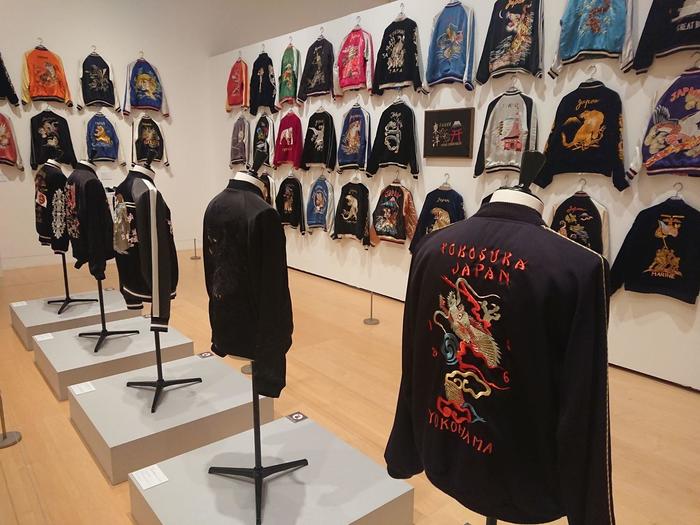
Sukajan is said to have been born in the 1940s, shortly after the war.
Many stalls were lined up in Ginza, Tokyo, around Wako, which was requisitioned by GHQ and became a department store specializing in the occupation forces. Kimonos and obi obi were lined up at this stall as souvenirs coveted by American military officers, but the traditional Japanese items were unique souvenirs for them.
There was a Japanese person who noticed this. He got a hint from seeing a street vendor's jacket modeled after a baseball jacket, which is familiar to Americans, and began selling it with oriental embroidery that would please American military officers. When this jacket first appeared, it was called a souvenir jacket or souvenir jumper.
This souvenir jacket was apparently so popular that it sold out immediately after it was brought to a stall in Ginza, and PX, a shop inside a US military base, caught the eye of it. After that, when they began to be delivered through regular channels to US military bases across Japan, the demand increased so much that they couldn't keep up with the embroidery work. In addition to official routes, souvenir shops have opened around U.S. military bases across the country and are now selling jackets.
In Yokosuka, shops called ``souvenirs'' that sell many souvenirs for American soldiers have started to line the area around ``Dobita-dori'', which was originally called ``Honmachi-dori''.
Sukajan's roots were as souvenirs for American soldiers.
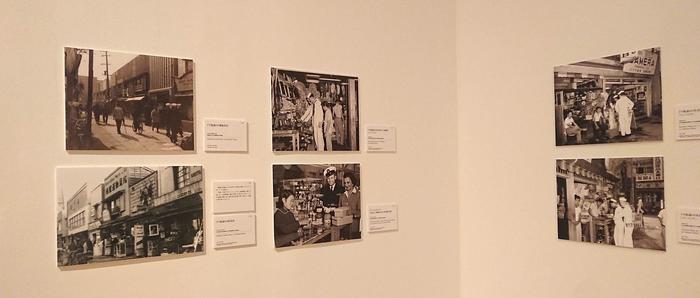
America is said to be a country of individualism, but it seems that it was a status quo for U.S. soldiers to have their own original designs embroidered on the part of their sailor uniforms that was hidden by the collar or on the lining of their clothes. Another popular souvenir was a portrait drawn on silk called a silk portrait. They bought portraits of themselves and their families, as well as things depicting Mt. Fuji, and returned to their home countries.
Both now and in the past, the beautiful scenery and culture of countries far away in the Far East must have touched their hearts. All of the exhibits were beautiful even for me, a Japanese person, and I thought they all represented Japan.
Dobuita Street
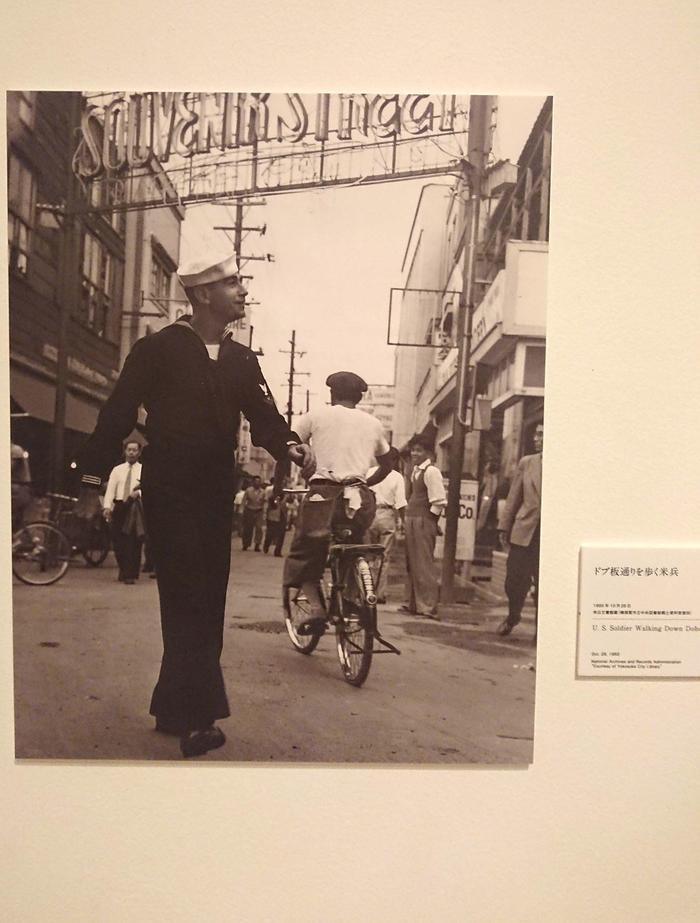
<<American Soldiers Walking Down Street> October 28, 1955, U.S. National Archives (provided by Yokosuka City Central Library Local Materials Room)>
It was originally called the ``Honmachi-dori Shopping Street,'' but the brook that used to flow along the street was covered with iron plates procured at the Yokosuka Naval Arsenal to allow people and cars to come and go. It came to be called "Itadori".
Souvenirs from before Skajan appeared
After the war, in Yokosuka, where the U.S. Navy base was located, many souvenir shops targeting U.S. soldiers, called ``souvenirs,'' were lined up around Dobuita Street, selling a variety of souvenirs.
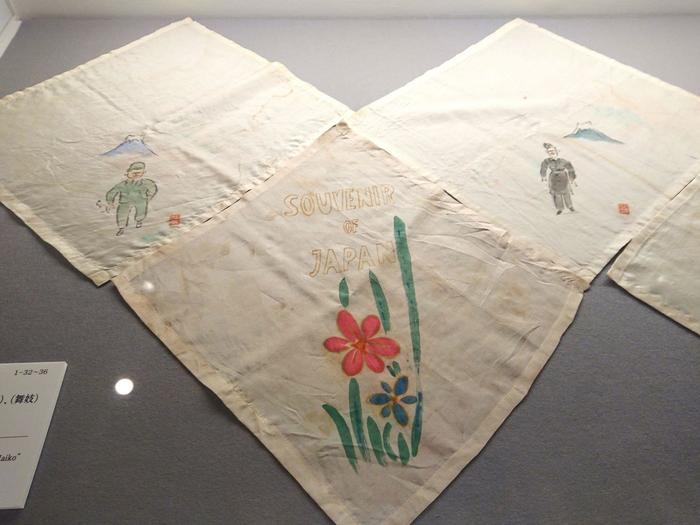
<<Souvenir handkerchief>> Late 1940s to early 1950s, Yokosuka City Central Library Local Materials Room>
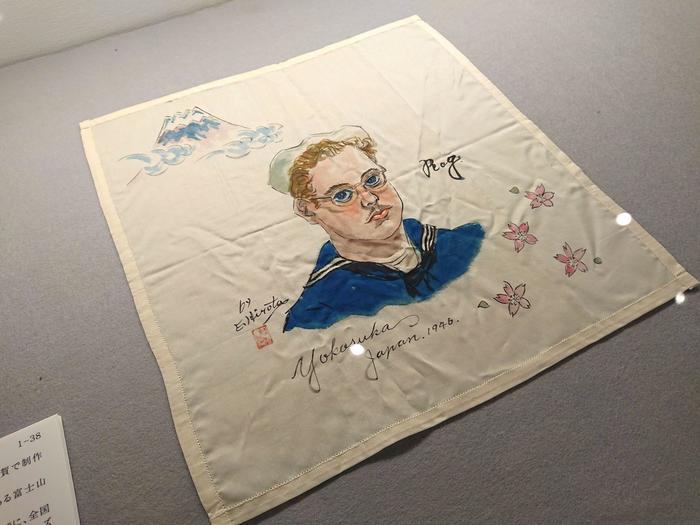
<<Caricature Scarf "Yokosuka Japan 1946"> 1946 Collection of Tomoji Yokochi Hiroumi>
Portrait
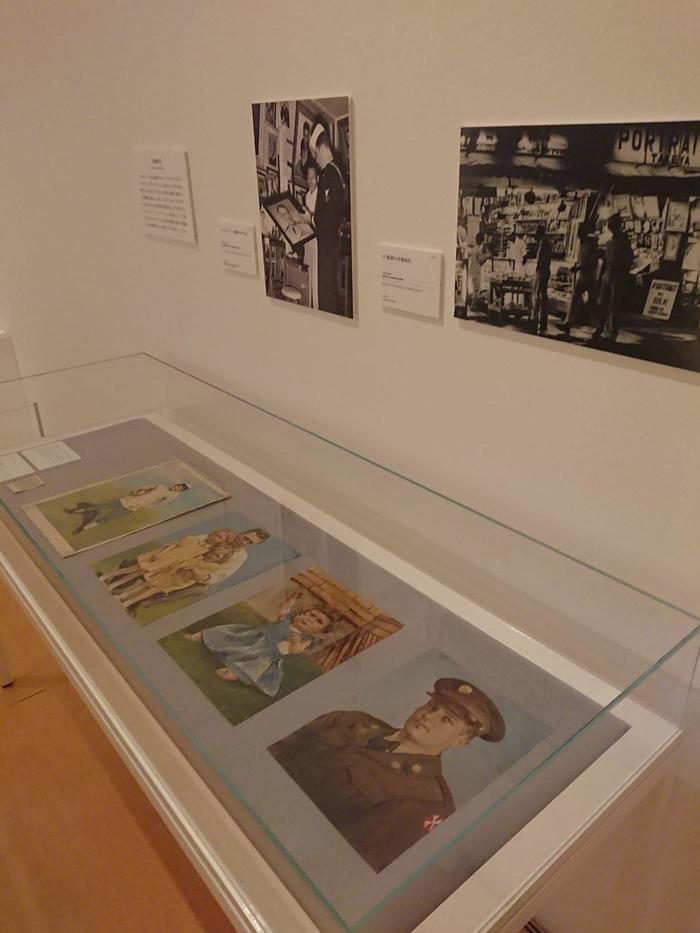
<<Silk Portrait>> Late 1940s to early 1950s, Yokosuka City Museum of Nature and Humanities>
From the 1940s to the 1950s, color photographs were expensive, so large, painted silk portraits, called silk portraits, became popular. It is said that people had portraits of themselves, family members, and lovers drawn on them and brought them back to their home countries. It seems that the novelty of painting on silk was popular with American soldiers at the time. It's a world away from today, when you can easily take photos with your smartphone.
Embroidery and custom culture
It seems that American soldiers have long had a habit of customizing their belongings and equipment, including embroidery and decorations on the parts of their sailor uniforms that were hidden behind the large collars and on their bags. As expected of Americans, we are an individualistic country.
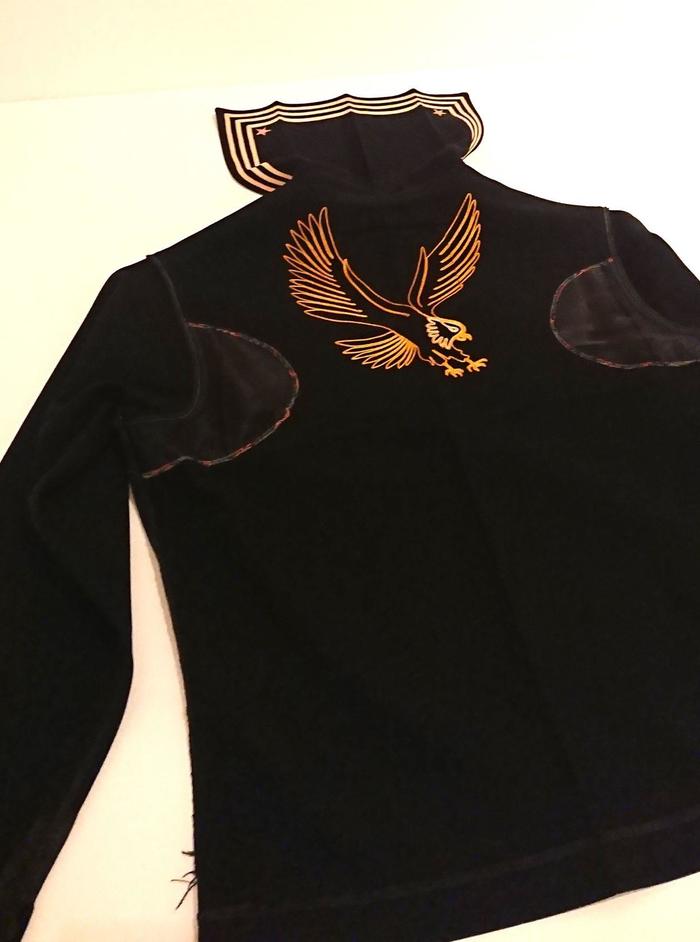
<<Custom Sailor Uniform "Eagle Embroidered on the Reverse Side"> (detail) Early 1940s Collection of Tomoji Yokochi Hiroumi>
A large eagle is embroidered on the back. But don't you think it's cool? It's their one and only original.
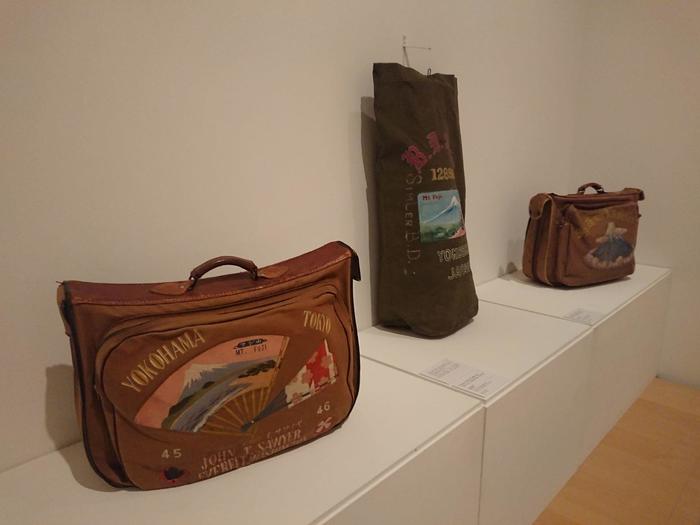
<(Front) <Custom Painted Suit Case "YOKOHAMA TOKYO 45─46"> 1946 Collection of Tomoji Yokochi Hiroumi>
Mt. Fuji is also drawn on the bag. Mt. Fuji must have had an impact on Americans as well. You can check your name, affiliation name, date, etc. I'm too embarrassed to carry it around with me...lol
Cushion Cover
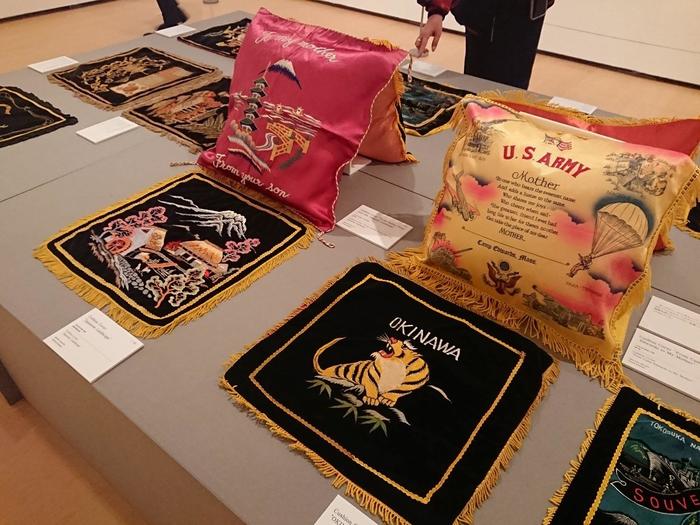
<(Center)《Cushion Cover "OKINAWA, Roaring Tiger"》Mid-late 1950s, Collection of Tomohiro Yokochi>
Some time after the war, the customs of American soldiers and the tastes of mainland America were introduced, and cushion covers and other items began to be made. About 30 years ago, I actually visited an American's home in San Francisco, and there was definitely a luxuriously embroidered cushion on the sofa.
vintage sukajan
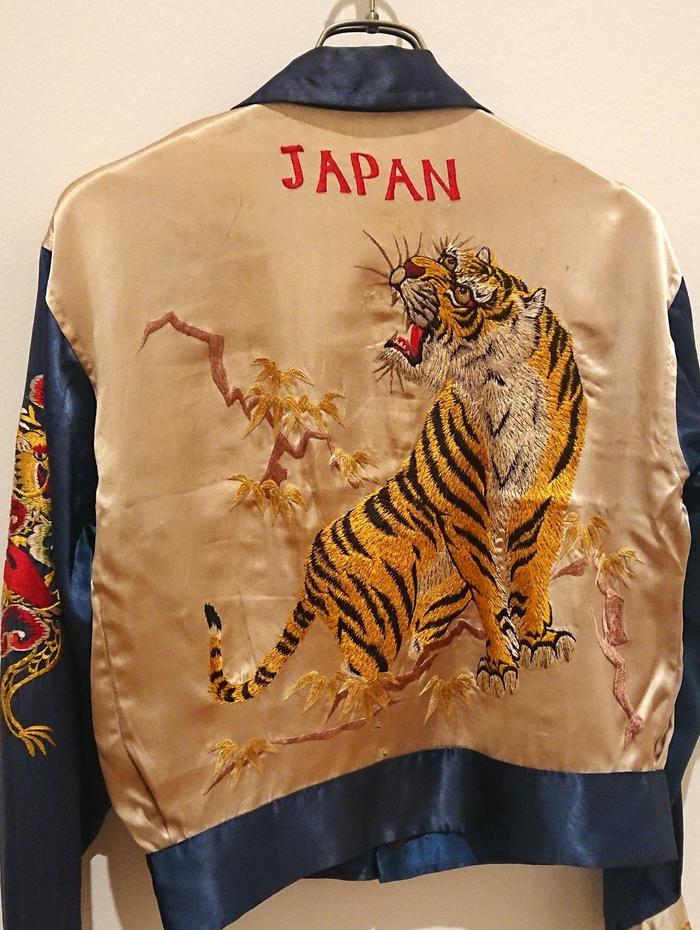
<《Bamboo and Roaring Tiger》Late 1940s to early 1950s, Taylor Toyo (Toyo Enterprises Co., Ltd.) collection>
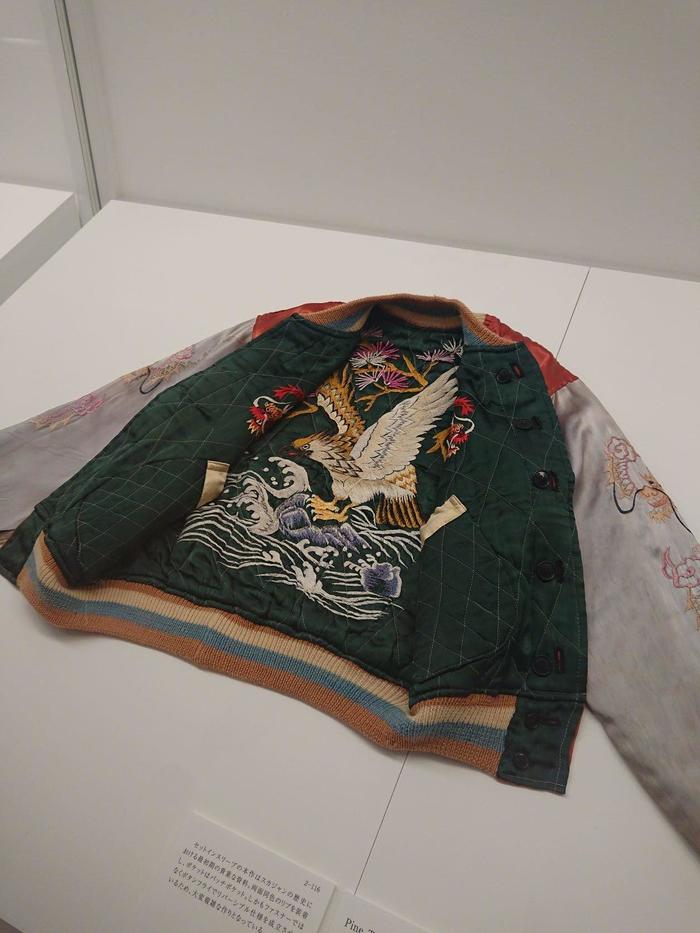
<《Pine Tree, Splash and Eagle》Late 1940s, Taylor Toyo (Toyo Enterprises Co., Ltd.) collection>
The main specifications of Sukajan are basically reversible, with different designs on the front and back. The fabrics used are acetate, velveteen, and quilting for the distinctive embroidery.
The unique feature of this jumper is a unique Japanese embroidery technique called ``Yokoburi embroidery'' (*), which uses a special sewing machine. The three-dimensional patterns that demonstrate the skill of the craftsman were distinctive. Since this technique was not available in other countries, jumpers with designs from countries other than Japan were also made in Japan.
*Horizontal embroidery: Using a ``horizontal sewing machine'' that does not have a general lock or fabric feeding function, the user moves the fabric by hand and embroiders while adjusting the speed with the foot pedal and the needle swing width with the lever on the right knee. It is something that requires experience and advanced techniques.
What became the motif of Sukajan
1. Dragon
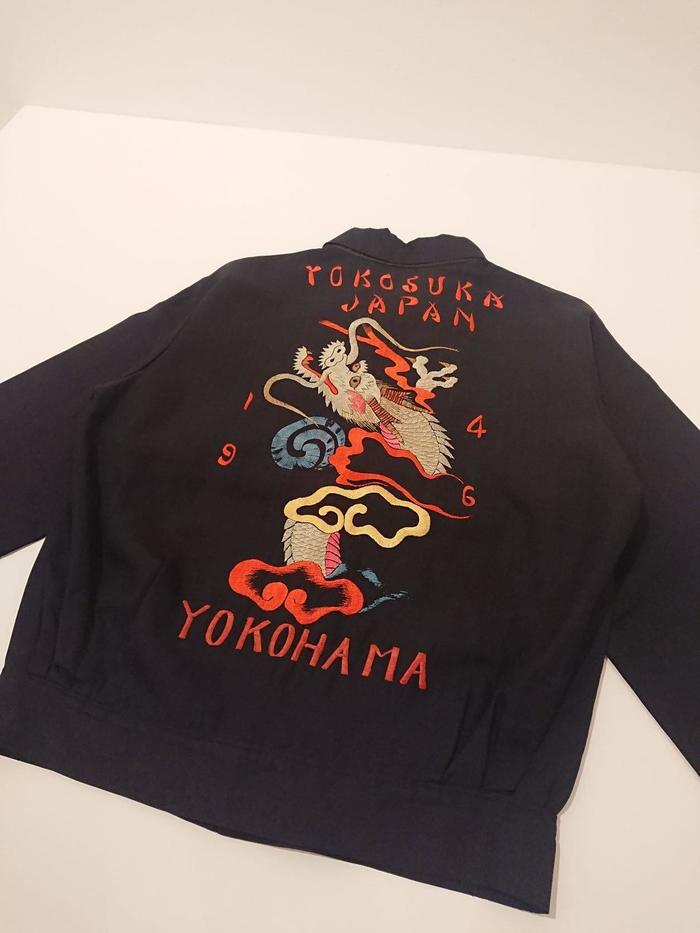
<<YOKOSUKA Dragon> (part) 1946, Taylor Toyo (Toyo Enterprises Co., Ltd.) collection>
Dragons are fictional creatures that are deified in the East. It is a representative oriental symbol among Westerners.
2. Eagle
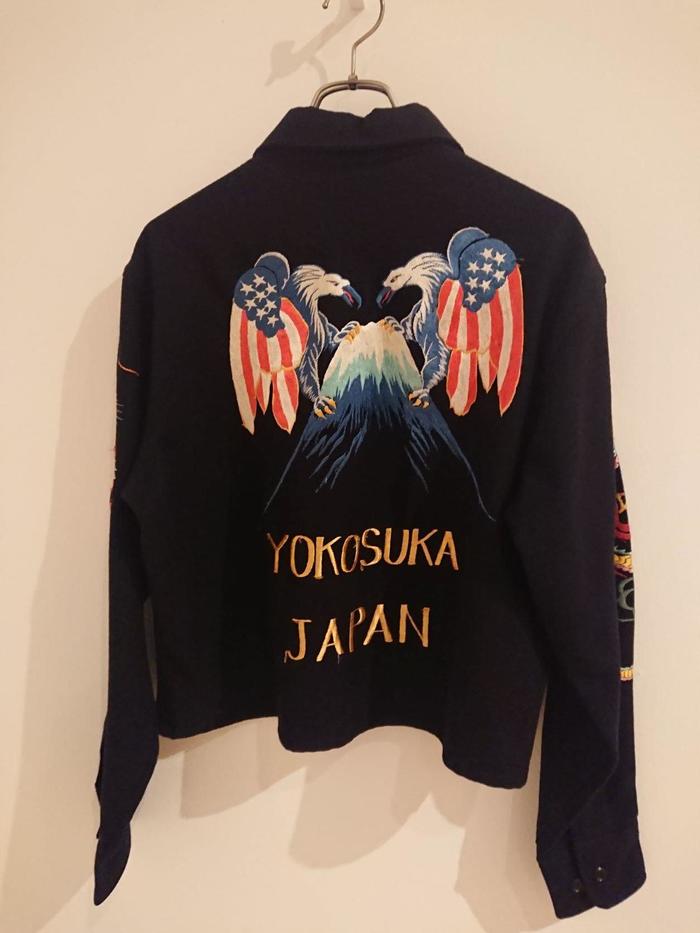
<《Souvenir Jacket "Mt. Fuji with Stars and Stripes Eagle, YOKOSUKA JAPAN"》Late 1940s Collection of Tomoji Yokochi Hiroumi>
The eagle was the most popular among American soldiers. This design is unique to America, where the bald eagle is the national bird.
3. Tiger
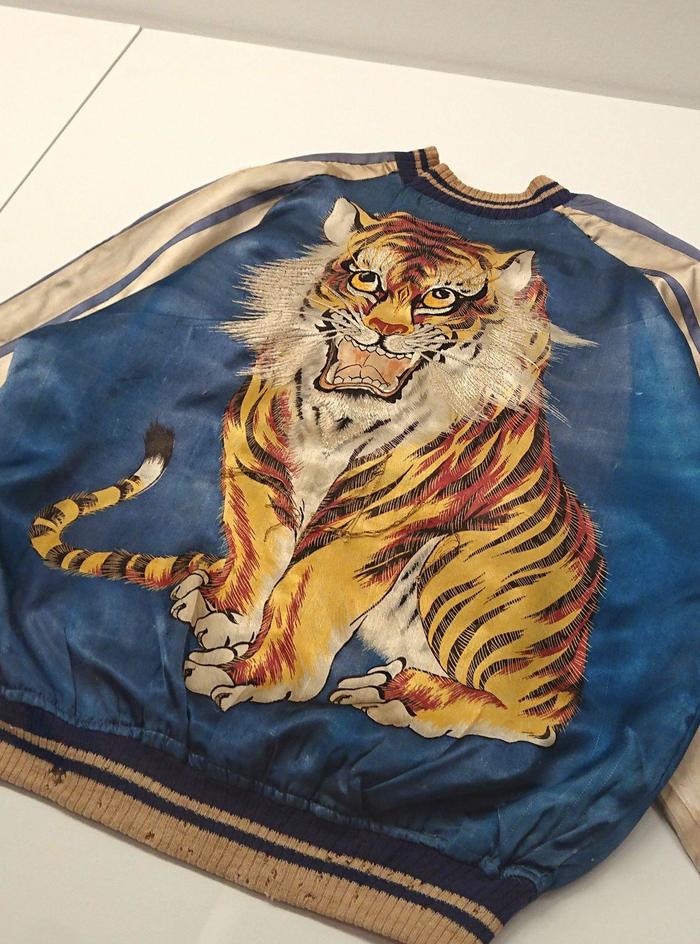
<《Roaring Tiger》Early 1950s, Taylor Toyo (Toyo Enterprises Co., Ltd.) collection>
The tiger, which reigns at the top of the animal kingdom, is widely found in Asia, and was favored by American soldiers as a symbol of strength. By the way, this tiger is not embroidered but printed. Do you understand? Please come and see for yourself how great it is at the Sukajan Exhibition.
4. Japanese map/scenery
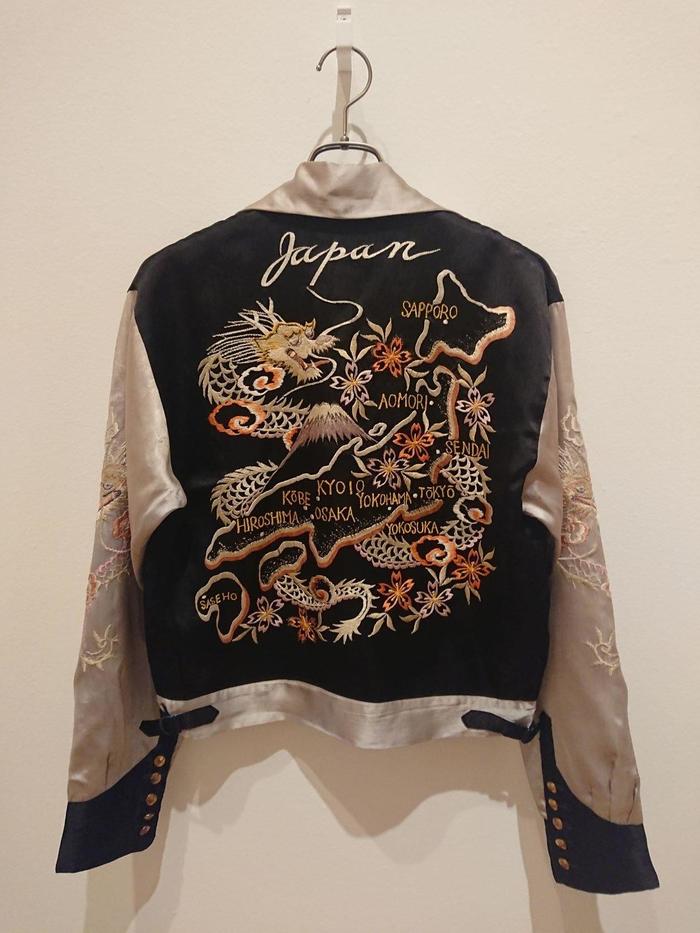
<《Dragon, Cherry Blossoms and Japan Map》Late 1940s, Taylor Toyo (Toyo Enterprises Co., Ltd.) collection>
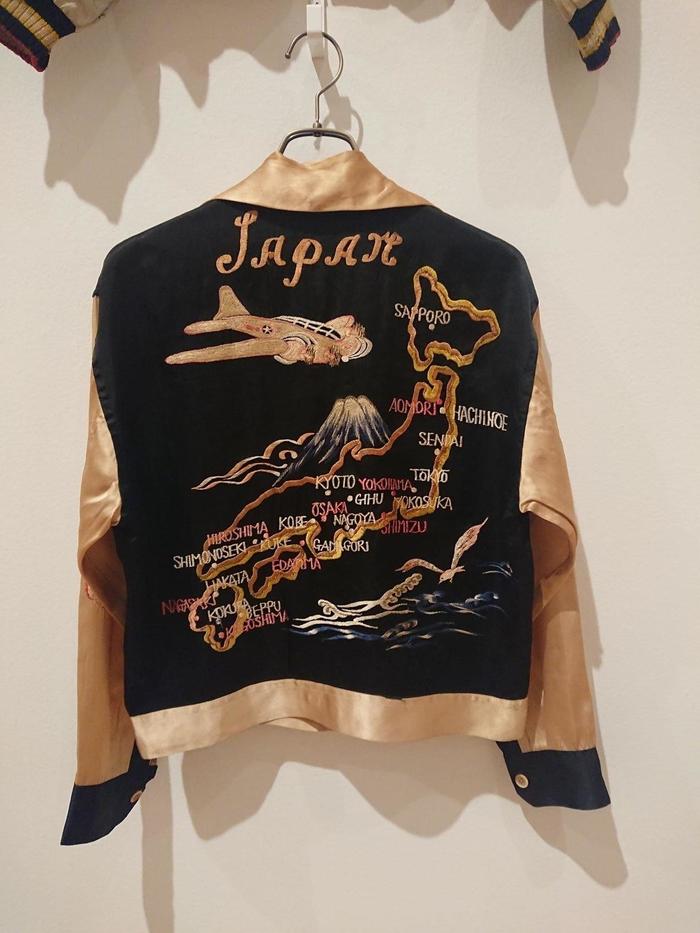
<《Flight Over Japan》Late 1940s, Taylor Toyo (Toyo Enterprises Co., Ltd.) collection>
The reversible Sukajan had an eagle, tiger, and dragon drawn on one side, and a map of Japan with designs such as Mt. Fuji and place names on the other side.
5. Overseas design
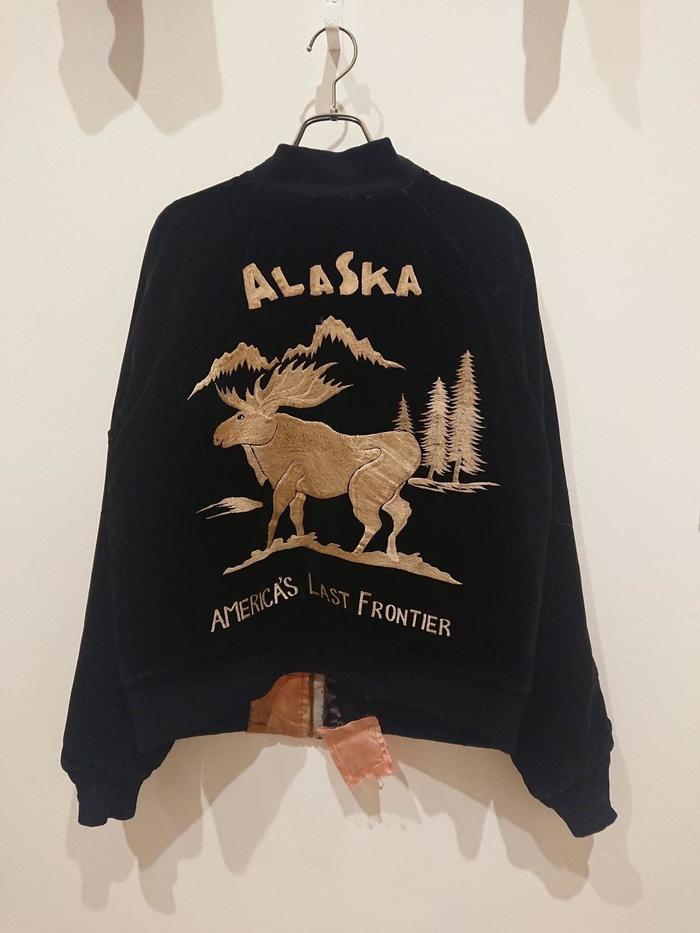
<《Alaskan Moose》Mid to late 1950s, Taylor Toyo (Toyo Enterprises Co., Ltd.) collection>
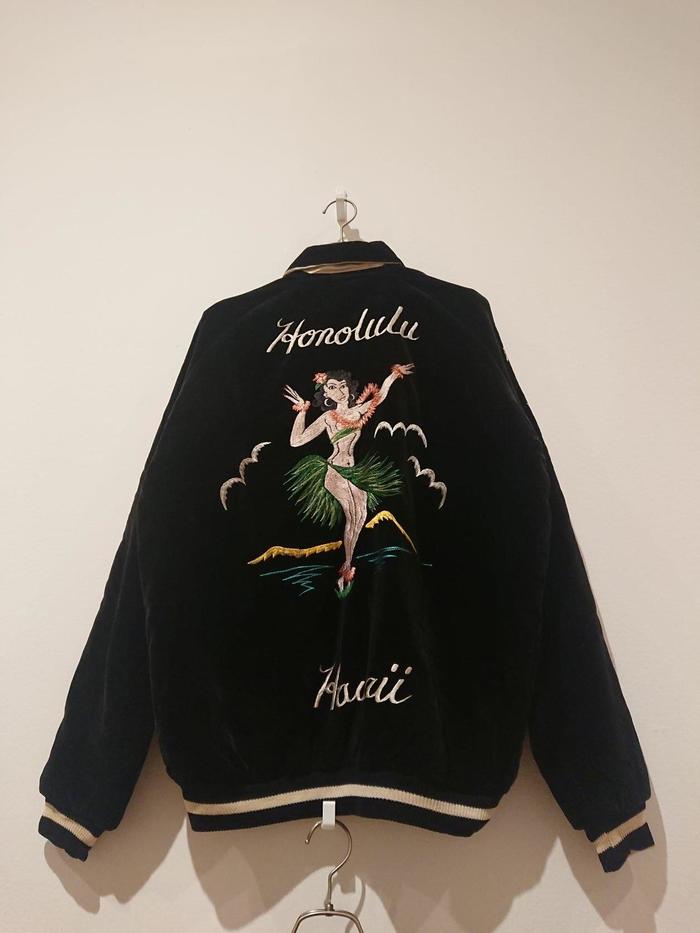
<《Hula Girl》Late 1950s, Taylor Toyo (Toyo Enterprises Co., Ltd.) collection>
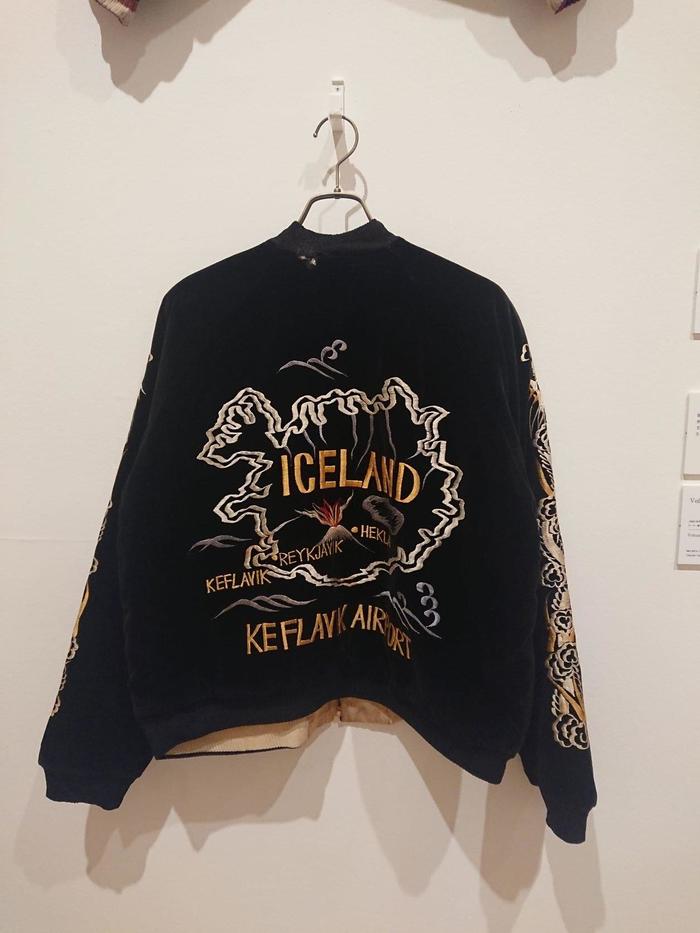
<《Volcano and Iceland Map》Mid to late 1950s, Taylor Toyo (Toyo Enterprises Co., Ltd.) collection>
The explosive popularity of Sukajan in Japan spread to US military bases around the world. Local Skajan jackets produced in Japan were sold all over the world.
6. Military
There were also sukajans embroidered in connection with the stage to which they belong. Sukajan was truly loved by American soldiers.
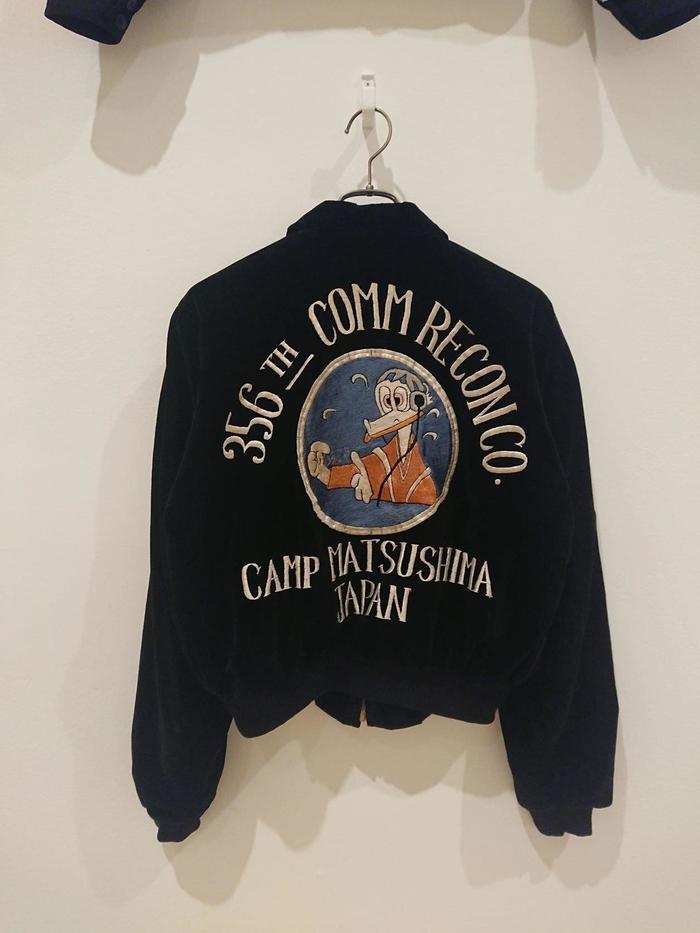
<《356th COMM RECON CO.》Mid to late 1950s, Taylor Toyo (Toyo Enterprises Co., Ltd.) collection>
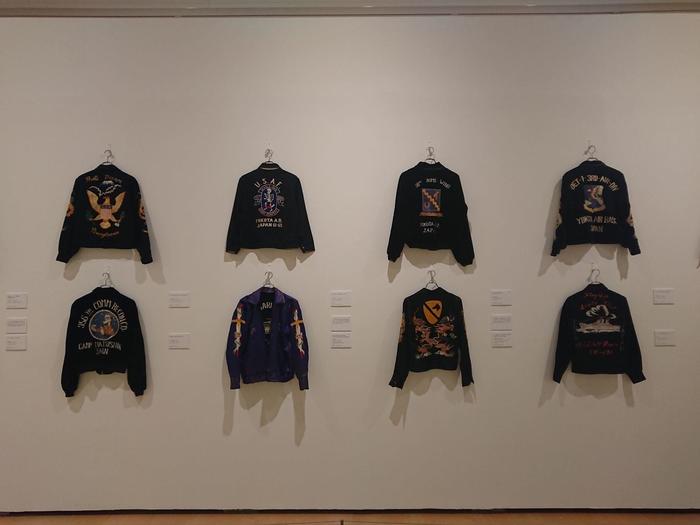
This is the report of the Sukajan Exhibition.
Many of these items on display were items brought back to Japan by American soldiers and then returned to Japan during the vintage clothing boom of the 1990s. It was a skajan exhibition that conveyed the feelings of American soldiers from the late 40's to the 50's.
Lastly
What did you think? I can't deny that it may be a bit of a spoiler, but I hope you found it to be a good idea to go see the Sukajan exhibition.
Now I'm an old man who doesn't care about fashion, wearing Uniqlo from head to toe, and I only thought of skajans as jumpers with flashy designs. However, I was overwhelmed when I saw so many Sukajans. This is amazing, I thought.
First of all, I thought it would be a loss if I didn't see it, and I also felt that I had to share this opportunity with the readers of Tabikofure.
At the Skajan Exhibition, I learned a bit about Japan's post-war recovery, and I realized that these are truly made in Japan, and that it is no exaggeration to say that each piece of clothing is a work of art. . But you won't know until you see it in real life. . .
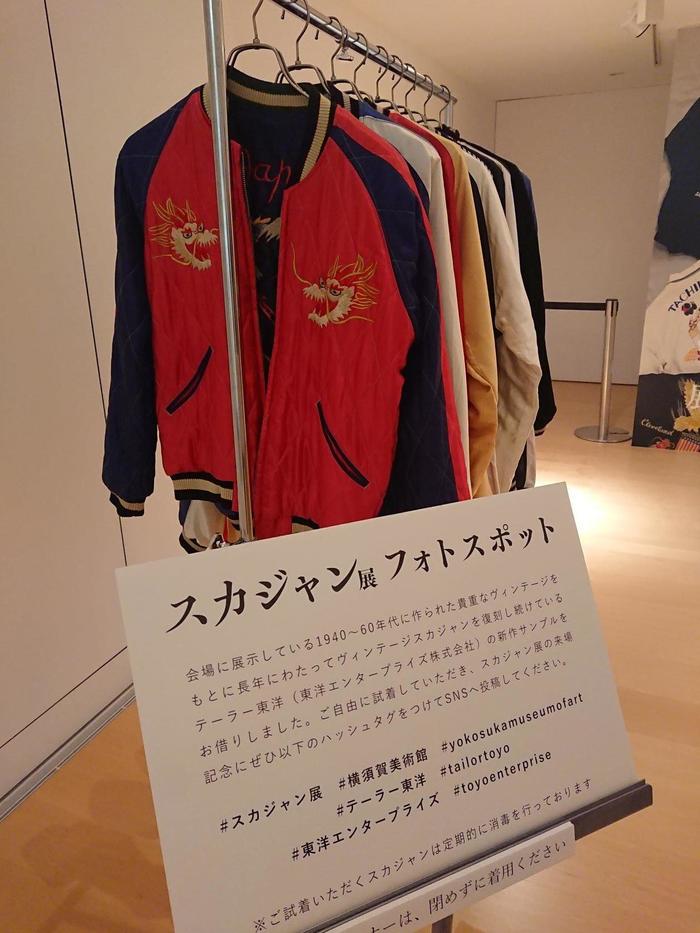
You can also take photos wearing vintage skajans.
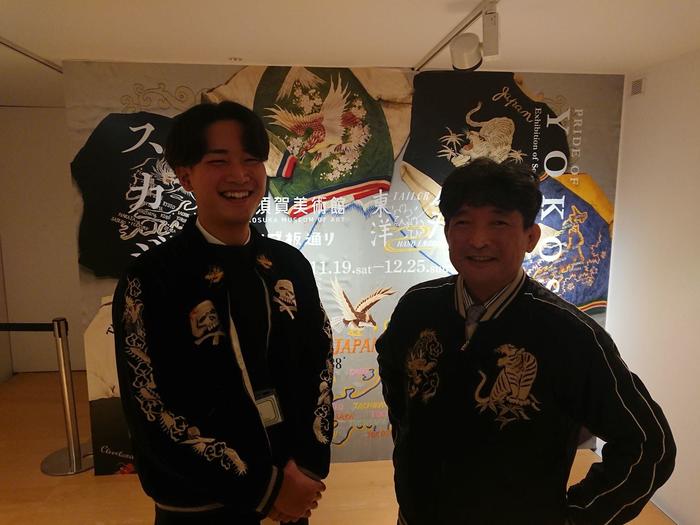
<Mr. Honma (left) and the author (right) of the Yokosuka Museum of Art, which we were shown around this time>
*Normally, photography of the vintage sukajans on display is prohibited, but this time we received special permission from the Yokosuka Museum of Art to photograph and post them. Thank you to everyone involved for your cooperation.
